Angela Ackerman's Blog: Writers Helping Writers, page 42
December 7, 2022
A Gift from Us: Secrets to Engaging Readers (Webinar)
This time of year, we usually host a spectacular giveaway called Advent Calendar for Writers, and you may have noticed it’s missing this go-around.
I’ll be honest – life’s been hectic. Both my boys had weddings this October (so awesome!), but then a house move and my husband’s major surgery followed (he’s recovering well, thank goodness!). Needless to say, my mental tank is pretty low, so we made the call to skip Advent this year.
 But are we skipping the gift-giving? Heck, no!
But are we skipping the gift-giving? Heck, no!If you’re interested in how to hack a reader’s brain using psychology and would like to know how a show-don’t-tell mindset steers you to opportunities to do more with your description, then this free webinar is for you!
Unfortunately because of some technical difficulties, it’s just me yammering away, but Becca’s there in spirit. We hope you find this dip into our process helpful, and that you walk away with ideas on how our thesauruses can help you write stronger characters and scenes. So, have a watch, and enjoy:
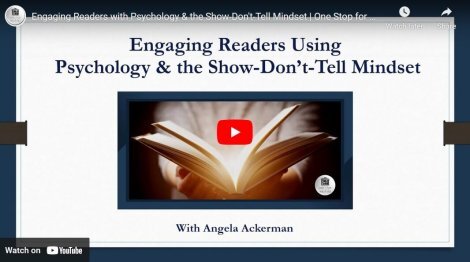
Psst! This is a limited time webinar, so make sure to view it before January 8th, and happy holidays!
The post A Gift from Us: Secrets to Engaging Readers (Webinar) appeared first on WRITERS HELPING WRITERS��.
December 6, 2022
3 Action-Reaction Misfires That Flatten Your Writing
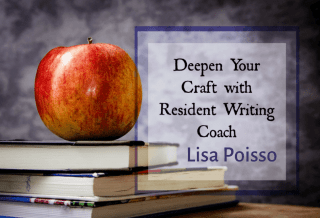
Cause and effect. Stimulus and response. Action and reaction. Everything in a story depends on what the characters do about whatever the story pushes them up against.
Stiff, disconnected, or missing character reactions snap the chain of cause and effect that constitutes your story. When readers can no longer see how and why the characters are doing what they���re doing, they lose the thread.
Let���s talk about the three most common action ���reaction misfires I see in manuscripts.
1. Missing or insufficient reactions
2. Jumbled responses
3. Purposely obscured stimuli
When characters fail to react to what���s happening around them, it’s as if nothing is happening at all. A snappy line of dialogue goes nowhere if it doesn���t get under someone���s skin. The first glimpse of a long-sought clue builds no excitement if nobody notices it. A punch in the nose might as well not have landed if it doesn���t start or end a disagreement.
When characters don���t react to the conversations and events around them, readers will assume they don���t care. If the characters don’t care, why should readers?
Keeping your characters engaged in the story keeps readers engaged with it too. When writing viewpoint characters, you have access to both internal and external responses. For other characters, you���re limited to whatever visible manifestations of those responses that the viewpoint character or narrator can perceive.
Internal ResponsesAll but the last type of internal response, thought, are involuntary reactions.
1. Involuntary sensations���These include physical sensations such as feeling a lump in the throat or a stomach full of butterflies.
2. Reflex reactions���These are the so-called knee-jerk reactions, such as jerking away from the source of pain.
3. Emotions���Before you can reveal emotions using any of these reaction modes, you as the writer must know what the emotion or blend of emotions actually is.
4. Thoughts���What���s the uncensored commentary running in the privacy of the character���s mind?
External ResponsesThese responses are conscious, voluntary reactions.
1. Voluntary action���These range from small-scale gestures (fist-pumping with glee) to story-moving choices (drawing a sword and attacking the duke).
2. Dialogue������We���ve never done it that way before���I don���t think it works like that,��� or ���I think I���m falling in love with you.���
Pro tip: Calibrate the number and scope of the responses to the significance of the stimulus. Dropping your keys on the floor merits a much smaller reaction than dropping your phone overboard into the sea. The more significant the stimulus, the more responses you can layer in. Tune with care. Over- or undercalibration makes the writing seem either melodramatic or flat.
Jumbled Responses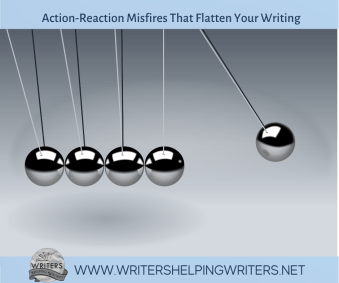
Almost as confusing to readers as a character who fails to react is a jumbled reaction that pulls the logical order of stimulus���response out of whack.
He scrabbled away from the roiling heap in which he���d landed. ���Get them off, get them off!���
It was ants���enraged, mandible-clacking ants, streaming over every inch of exposed skin. His whole frame jerked spasmodically, and a lacy net of agony cinched around his legs.
In this example, the hapless adventurer reacts by leaping away and shouting before readers even know there���s a problem. The narrator must loop back to explain (It was ants) and fill in the details. That���s not a dramatization of what���s happening (showing); it���s an explanation after the fact (telling).
Stimulus and response follows a predictable physiological pattern of perception and reaction. As a general rule of thumb, involuntary reactions come first. Next comes thought, as the character processes what���s happening. Finally, the character voluntarily and consciously reacts through action and dialogue.
STIMULUS���Our ill-fated adventurer tumbles into an ant hill.
1. INTERNAL RESPONSE���Sensation (involuntary): A lacy net of agony cinched around his legs.
2. INTERNAL RESPONSE���Reflex (involuntary): His whole frame jerked spasmodically ���
3. INTERNAL RESPONSE���Thought (voluntary): It was ants���enraged, mandible-clacking ants, streaming over every inch of exposed skin.
4. INTERNAL RESPONSE���Emotion (involuntary): Panic. You have a small window of creative leeway here. You could position this involuntary emotion after the voluntary thought in which he concludes that he���s covered in ants, or you could show him panicked by the sheer onslaught of physical reactions.
5. EXTERNAL RESPONSE���Action (voluntary): He scrabbled away from the roiling heap in which he���d landed. The order of these last voluntary actions is your call; your hero might shout first, then scrabble.
6. EXTERNAL RESPONSE���Dialogue (voluntary): ���Get them off, get them off!���
Poor guy.
Here���s how the passage would read if the scene were written following a physiologically logical order of reactions. You may give him an extra voluntary action (He peered down) in reaction to the pain, which allows him to reach the conclusion that inspires his next move.
A lacy net of agony cinched around his leg, and his whole frame jerked spasmodically. He peered down: Ants. Enraged, mandible-clacking ants, streaming over every inch of exposed skin.
He scrabbled away from the roiling heap in which he���d landed. ���Get them off, get them off!���
Purposely Obscured StimuliWhen you���re straining to create suspense, it���s easy to fall into withholding information���what I call Mysterioso Syndrome, the refusal to show readers what the characters are already clearly reacting to. This heavy-handed technique attempts to build dramatic tension by hiding or failing to identify the stimulus.
Let���s go back to the original, jumbled account of our hero���s tumble into the ant hill.
He scrabbled away from the roiling heap in which he���d landed. ���Get them off, get them off!���
It was ants���enraged, mandible-clacking ants, streaming over every inch of exposed skin. His whole frame jerked spasmodically, and a lacy net of agony cinched around his legs.
If the first paragraph were the end of the chapter, this dash of confusion could add a zing of cliffhanger-ish suspense.
But in the middle of a scene, refusing to let readers see what���s making our adventurer scrabble and shout momentarily puts the story on hold. It forces readers to wait for you to finish your clever little wait-for-it moment and get out of the way so that they, too, can see whatever the character���s in such a twist about.
Take heed: Modern readers want to see the story for themselves, not be left idling in the margins while you parse out explanations one crumb at a time. Let readers into the story: Cause, then effect. Stimulus, then response. Action, then reaction.
The post 3 Action-Reaction Misfires That Flatten Your Writing appeared first on WRITERS HELPING WRITERS��.
December 3, 2022
Fear Thesaurus Entry: Losing One’s Heritage or Cultural Identity
Debilitating fears are a problem for everyone, an unfortunate part of the human experience. Whether they’re a result of learned behavior as a child, are related to a mental health condition, or stem from a past wounding event, these fears influence a character’s behaviors, habits, beliefs, and personality traits. The compulsion to avoid what they fear will drive characters away from certain people, events, and situations and hold them back in life.
In your story, this primary fear (or group of fears) will constantly challenge the goal the character is pursuing, tempting them to retreat, settle, and give up on what they want most. Because this fear must be addressed for them to achieve success, balance, and fulfillment, it plays a pivotal part in both character arc and the overall story.
This thesaurus explores the various fears that might be plaguing your character. Use it to understand and utilize fears to fully develop your characters and steer them through their story arc. Please note that this isn’t a self-diagnosis tool. Fears are common in the real world, and while we may at times share similar tendencies as characters, the entry below is for fiction writing purposes only.
 Fear of Losing One’s Heritage or Cultural Identity
Fear of Losing One’s Heritage or Cultural IdentityNotes
Cultural differences���ones we adopt or are born into���are part of what define us. For a character who understands this, losing that aspect of their identity can shake the foundation of who they are and threaten the deep connections they have with others from their culture. This is an enormous loss. While it’s normal and healthy to nurture one’s heritage for oneself and one’s family, a fear of losing that sense of identity���whether the possibility is real or perceived���can drive the character to great (even unhealthy) lengths to keep it from happening.
What It Looks Like
Holding firmly to personal traditions
Observing cultural rituals to keep them alive and relevant
The character educating their children about their culture: engaging in traditions, telling them stories about their heritage, speaking their native language at home, etc.
Seeking to educate others about the character’s culture���forming a club at school or a committee at work, for instance
Becoming an activist
The character seeing offense or slights against their culture where none were intended
Refusing to assimilate or integrate into a different culture
Living a life at home that looks different from the character’s life outside of the home
Only associating with people within the character’s cultural group
The character sheltering their children from influences outside of their community
The character unintentionally passing their fear of others to their children
Requiring loved ones to choose spouses from within their cultural group
Scorning those outside of the character’s community (rejecting them before they can reject the character)
Developing an��us vs. them��mentality
Common Internal Struggles
The character wanting to maintain their cultural identity but also wanting to fit in with others
Feeling conflicted about their identity
Being drawn to the practices of other cultures and feeling disloyal
Fearing certain people groups outside of the character’s community
The character constantly fearing that they’re losing their children to another culture
The character wanting to protect their children from being drawn away by other cultures but recognizing that doing so is damaging their relationship
Flaws That May Emerge
Abrasive, Confrontational, Cynical, Defensive, Haughty, Hostile, Impatient, Impulsive, Inhibited, Insecure, Judgmental, Martyr, Melodramatic, Oversensitive, Pessimistic, Resentful, Suspicious
Hindrances and Disruptions to the Character’s Life
Missing out on valuable experiences, learning opportunities, and advances from other cultures that could benefit the character
Experiencing discrimination or harassment for their beliefs
Strained relationships with family members who want to integrate with the rest of the world
Only feeling safe and understood within their own community
Always feeling like an outsider
Becoming judgmental or prejudicial about people from other cultures
Scenarios That Might Awaken This Fear
A natural disaster or human conflict destroying a sacred site
Seeing other people’s children abandon their heritage
A child choosing to date someone from outside of the family’s culture
Witnessing the passage of laws that target their culture or heritage (prohibiting certain headwear, a form of worship being forbidden, etc.)
Being targeted because of the character’s heritage
Being pressured to fit in
A “bad apple” who shares the character’s culture committing a crime or gaining notoriety, generating animosity from the public
Other Fear Thesaurus entries can be found here.
 Need More Descriptive Help?
Need More Descriptive Help?While this thesaurus is still being developed, the rest of our descriptive collection (16 unique thesauri and growing) is accessible through the One Stop for Writers THESAURUS database.
If you like, swing by and check out the video walkthrough for this site, and then give our Free Trial a spin.
The post Fear Thesaurus Entry: Losing One’s Heritage or Cultural Identity appeared first on WRITERS HELPING WRITERS��.
November 30, 2022
Writing Antagonists Readers Can���t Help But Like
There’s a dirty little secret among many of us readers: well-written antagonists get our blood pumping. When a scene come along with them in it, well, we lean closer. Grin a little more. Not because we’re a bunch of budding psychopaths and this is some alter-ego role play–okay, maybe a little–no, it’s that deep down, there’s something we like about them. Maybe even admire.

What now? you say. How is that possible? He (or she) is the baddie, after all!
Indeed. And we know it. But just like a protagonist, the antagonist can have something special about them too. It’s not a hollow quirk, catch-phrase, or great sense of style that draws us in. No, it’s something deeper, something attached to their identity or life experience. We see this part of them and relate to it because it reminds us of something we’ve seen or experienced in our own real-world journey.
Is relatability only for protagonists?A lot of airtime is devoted to building a relatable protagonist because it makes the character accessible to readers in a meaningful way. Relatability is a rope that ties the two together – in some significant way, readers see the hero or heroine is like them. Maybe they’ve both felt the same thing, been in the same situation, experienced the same heartache or sting of failure. This common ground helps a bond of understanding and empathy to form, and the reader becomes invested in what happens to the character. They root for the protagonist and care what happens to them.
We don’t see as much written on the subject of relatability when it comes to the antagonist or villain because writers are supposed to nudge the reader into the protagonist’s camp, not the antagonist’s. Unfortunately, though, this can send the wrong message about the importance of our darker characters, leading to some writers glossing over their development so they end up with clich��, yawn-worthy villains.
Antagonists should be as developed as protagonists.
They should have understandable motivations (for them), have a history that shows what led them down the dark alley of life, and an identity, personality, and qualities that make them a tough adversary for the protagonist to beat. The more dedicated, skilled, and motivated the antagonist is, the more of a challenge they will be, leading to great friction, tension, clashes, and conflict.
So, just as we want to show readers a protagonist’s inner layers and give them ways to connect and care about the protagonist, we should encourage readers to find something good or relatable about the antagonist so it causes the reader to be conflicted. They may not agree with the antagonists’ goal or how they go about getting it, but maybe they understand why this story baddie wants what they want, or they admire certain qualities they have.
When readers are torn over how to feel, they become more invested in the story.Life is not always black and white, is it? So it’s okay if a tug of war goes on inside them over who is right and who is wrong in the story, or if they care enough about the villain to hope they will choose to turn from their dark path, and redemption may be possible.
So how do we make an antagonist relatable?
Common human experiences, especially ones that encourage moral confliction, are a great way to show readers they have something in common with the antagonist. For example, consider temptation.
Haven’t you ever been tempted to cross a moral line?
Did you ever want to make someone pay because they deserved it?
Have you ever ignored society’s rules because they don’t make sense, are unfair, or were built to benefit a select few?
Temptation is something we’ve all felt, and wrestle with. Sometimes we remain steadfast, other times we give in. So having a darker character be tempted in a way readers relate to will cause them to identify with the antagonist’s mindset.
Another way to use temptation is to get readers to imagine the what if, which can be another area of common ground:
What if you could easily let go of guilt and do what feels right for you? What if you could break the law for the right reasons and serve a greater good? What if you could go back in time and erase someone who really deserves to be erased?This can work well if you tie the antagonist’s desire to embrace the dark side because of a past trauma. For example…
Maybe they do whatever feels right because they were enslaved by a cruel master as a childThey break the law because those who make them are corrupt and entitledThey go back and erase someone because that person killed their beloved and unborn childCan’t we all relate to these dark motivations just a little? Don’t they help us understand where the character’s behavior is coming from? We may not morally agree with what the antagonist does, but we do feel some connection to them.
And I’m convinced this last one is the key because antagonists and villains have an Achilles heel: their role. As soon as it’s clear they are cast as the Bad Guy or Gal, readers put them in a box. They must be a jerk, a sore loser, a narcissist, someone who’s all about power and control. They must be unlikable.
And I don’t know about you, but when the antagonist or villain turns out to be exactly those things, I’m disappointed. Why? Because it’s expected: good guy faces off against typical bad guy, good guy wins. Yawn.
Relatability makes it okay to like the antagonist, even though they do bad things.So, to recap and offer a few more ideas…
Craft a backstory that���s as well-drawn as the Protagonist’s. As the author, you need to know why they’re messed up and take the dark path. Use a past tragedy to help readers understand what led them to their role. Maybe you can even reveal this in a way that causes readers to wonder if they would be any different had they been in the antagonist’s shoes.

Give them a credible, understandable motivation. Even if their goal is a destructive one, they should have a good reason for wanting it. (For ideas on what this could look like, check out the Dark Motivations in this database.)
Give them a talent, something helpful or interesting. Just like a protagonist, your antagonist likely is skilled in some way. What talent or skill will help them achieve their goal? And you can always make this an interesting dichotomy, like an antagonist with a talent for healing who takes in hurt animals but lacks the same empathy for humans.
Give them a quality or trait that is undeniably admirable. It’s easy to paint a villain as being all bad, so skip the clich�� and give them a belief they live by. Maybe they keep every promise or hold honestly in the highest regard and so are always truthful, even if it makes them look bad. Of course, the dark side might be that they don���t suffer lies of any kind, and punish them severely.
Make them human. Sometimes writers can go on a “power and glory” tear and forget their antagonist is as prone to ���Average Joe��� problems as anyone else. Does their roof leak, do they have visitors show up at an inconvenient time, do they get sick?
Antagonists can have a hobby or secret, struggle over what to do, or regret words said in haste just like the rest of us. So while you highlight their dark ways and volatile emotions, remember to also show how in some ways, they’re just like anyone else.
The post Writing Antagonists Readers Can���t Help But Like appeared first on WRITERS HELPING WRITERS��.
Writing Antagonists that Readers Can���t Help But Like
There’s a dirty little secret among many of us readers: well-written antagonists get our blood pumping. When a scene come along with them in it, well, we lean closer. Grin a little more. Not because we’re a bunch of budding psychopaths and this is some alter-ego role play–okay, maybe a little–no, it’s that deep down, there’s something we like about them. Maybe even admire.

What now? you say. How is that possible? He (or she) is the baddie, after all!
Indeed. And we know it. But just like a protagonist, the antagonist can have something special about them too. It’s not a hollow quirk, catch-phrase, or great sense of style that draws us in. No, it’s something deeper, something attached to their identity or life experience. We see this part of them and relate to it because it reminds us of something we’ve seen or experienced in our own real-world journey.
Is relatability only for protagonists?A lot of airtime is devoted to building a relatable protagonist because it makes the character accessible to readers in a meaningful way. Relatability is a rope that ties the two together – in some significant way, readers see the hero or heroine is like them. Maybe they’ve both felt the same thing, been in the same situation, experienced the same heartache or sting of failure. This common ground helps a bond of understanding and empathy to form, and the reader becomes invested in what happens to the character. They root for the protagonist and care what happens to them.
We don’t see as much written on the subject of relatability when it comes to the antagonist or villain because writers are supposed to nudge the reader into the protagonist’s camp, not the antagonist’s. Unfortunately, though, this can send the wrong message about the importance of our darker characters, leading to some writers glossing over their development so they end up with clich��, yawn-worthy villains.
Antagonists should be as developed as protagonists.
They should have understandable motivations (for them), have a history that shows what led them down the dark alley of life, and an identity, personality, and qualities that make them a tough adversary for the protagonist to beat. The more dedicated, skilled, and motivated the antagonist is, the more of a challenge they will be, leading to great friction, tension, clashes, and conflict.
So, just as we want to show readers a protagonist’s inner layers and give them ways to connect and care about the protagonist, we should encourage readers to find something good or relatable about the antagonist so it causes the reader to be conflicted. They may not agree with the antagonists’ goal or how they go about getting it, but maybe they understand why this story baddie wants what they want, or they admire certain qualities they have.
When readers are torn over how to feel, they become more invested in the story.Life is not always black and white, is it? So it’s okay if a tug of war goes on inside them over who is right and who is wrong in the story, or if they care enough about the villain to hope they will choose to turn from their dark path, and that redemption may be possible.
So how do we make an antagonist relatable?
Common human experiences, especially ones that encourage moral confliction, are a great way to show readers they have something in common with the antagonist. For example, consider temptation.
Haven’t you ever been tempted to cross a moral line?
Did you ever want to make someone pay because they truly deserve it?
Have you ever ignored society’s rules because they don’t make sense, seem fair, or were built to benefit a select few?
Temptation is something we’ve all felt, and wrestle with. Sometimes we remain steadfast, other times we give in. So having a darker character face a temptation that readers relate to will cause them to identify with the antagonist’s mindset because they’ve been there themselves.
Another way to use temptation is to get readers to imagine the what if, which can be another area of common ground:
What if you could just let go of guilt and do what feels right for you? What if you could break the law for the right reasons and serve a greater good? What if you could go back in time and erase someone who really deserves to be erased?This can work well if you tie the antagonist’s desire to embrace the dark side of morality because of a past trauma. For example…
Maybe they do whatever feels right because they were enslaved by a cruel master as a childThey break the law because those who make them are corrupt and entitledThey go back and erase someone because that person killed their beloved and unborn childCan’t we all relate to these dark motivations just a little bit? Don’t they help us understand where the character’s behavior is coming from? We may not morally agree with what the antagonist does, but we do feel some connection to them.
And I’m convinced this last one is the key because antagonists and villains have an Achilles heel: their role. As soon as it’s clear they are cast as the Bad Guy or Gal, readers put them in a box. They must be a jerk, a sore loser, a narcissist, someone who’s all about power and control. They must be unlikable.
And I don’t know about you, but when the antagonist or villain turns out to be exactly those things, I’m disappointed. Why? Because it’s expected: good guy faces off against typical bad guy, good guy wins. Yawn.
Relatability makes it okay to like the antagonist, even though they do bad things.So, to recap and offer a few more ideas…
Craft a backstory that���s as well-drawn as the Protagonist’s. As the author, you need to know why they’re messed up and take the dark path. Use a past tragedy to help readers understand what led them to their role. Maybe you can even reveal this in a way that causes readers to wonder if they would be any different had they been in the antagonist’s shoes.��

Give them a credible, understandable motivation. Even if their goal is a destructive one, they should have a good reason for wanting it. (For ideas on what this could look like, check out the Dark Motivations in this database.)
Give them a talent, something helpful or interesting. Just like a protagonist, your antagonist likely is skilled in some way. What talent or skill will help them achieve their goal? And you can always make this an interesting dichotomy, like an antagonist with a talent for healing who takes in hurt animals but lacks the same empathy for humans.��
Give them a quality or trait that is undeniably admirable. It’s easy to paint a villain as being all bad, so skip the clich�� and give them a belief they live by. Maybe they keep every promise or hold honestly in the highest regard and so are always truthful, even if it makes them look bad. Of course, the dark side might be that they don���t suffer lies of any kind, and punish them severely.
Make them human. Sometimes writers can go on a “power and glory” tear and forget their antagonist is as prone to ���Average Joe��� problems as anyone else. Does their roof leak, do they have visitors show up at an inconvenient time, do they get sick?
Antagonists can have a hobby or secret, struggle over what to do, or regret something they said just like the rest of us. So while you highlight their dark ways and emotions, remember to show that in some regards, they are just like anyone else!
The post Writing Antagonists that Readers Can���t Help But Like appeared first on WRITERS HELPING WRITERS��.
November 28, 2022
Our Favorite Gifts for Writers

It’s that time of year when we’re thinking about upcoming holidays and the people in our lives who love writing as much as we do. Critique partners, accountability chums, fellow scribblers in the trenches…this is a great time to give them a little something to show them how special they are to us, and to show support of their author goals.
This year we wanted to share a few of our favorite things because we think they’ll make great gifts. (A few are affiliate links, but we only suggest things we like and think you will too.) Enjoy!
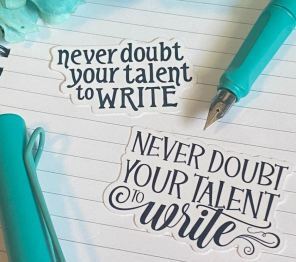 Motivational Stickers
Motivational StickersImagine opening your laptop and seeing an inspiring quote that gets you all pumped up – that’s what these great little stickers do.
Check out the huge variety of you can get from BiblioficDesigns!
 A Portable Desk
A Portable DeskWant to write on the couch, in bed, in the car or on the lounger in the backyard? Get this portable laptop desk.
I have one and use it all the time. I love being able to move around and find the best spot to inspire me as I work!
 Yankee Candles
Yankee CandlesBecca loves certain things – her kids, cats, peanut butter protein shakes, and yes, Yankee Candles.
Candles are a big part of her writing routine, and she always has one burning when it’s time to work because it triggers her brain to get down to business. This is a great addition to any writer’s desk, and heck, they smell so good!
 An Owl Mug
An Owl MugLook I’m not saying I have an owl addiction, but well, yeah, I have an owl addiction.
Owls are wise and make a great writerly mascot, so I think we both know you and every other writer need at least one mug…maybe two. And my goodness, look at this pair. I’m in love!
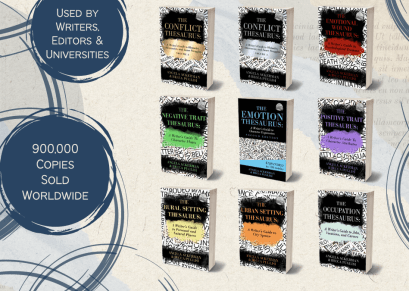 A Bestselling Writing Guide from Us
A Bestselling Writing Guide from UsBy now, you likely know we’re the authors behind The Emotion Thesaurus and its many sibling guides. These books have helped writers all over the world brainstorm stronger description and master show-don’t tell, and we love creating them.
If you are new to these books, you pick your topic, and then dive in. You’ll learn how to write that subject better, be it emotions, setting, personality, conflict, etc., and you’ll have a brainstorming resource (the ‘thesaurus’ part) that gives you constant ideas on how to bring your story to life.
Don’t know which book to get? The the Emotion Thesaurus (Blue), which is the most popular volume. Or, choose the Conflict Thesaurus (Gold & Silver), the last two releases. You’ll love having so many possible conflict scenarios on tap to help you write fresh, intense fiction.
 Literary Insults Poster
Literary Insults PosterThis poster was a birthday gift from my daughter-in-law, and I love it. It’s filled with great literary insults (that you can use, muahaha), so that’s fun, right?
It’s a neat collectable and conversation piece all in one, so frame this poster and then display it in your office with epic nerdy pride. I did!
 A Weighted Blanket
A Weighted BlanketOkay this is a super thoughtful gift, because we all know writers keep odd hours and never get enough sleep. So, make sure your sleep is quality by wrapping yourself in a heavy, fuzzy blanket that applies just enough pressure to make all your anxiety slip away. I got one a few years ago and have never slept better.
A Powerful Story Toolkit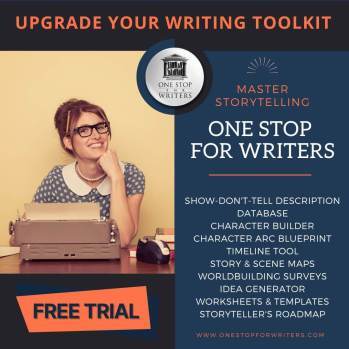
There’s no better story support than One Stop for Writers. With its massive show-don’t-tell database, innovative story tools, and the Storyteller’s Roadmap, planning, writing, and revising becomes so much easier.
Everything you need to create, all in one place. This is a game-changer for anyone who needs help writing stronger stories. A gift certificate makes a great stocking stuffer (1-month, 6-months, or 12-months) and the recipient will never forget how you supported them on the path to their author goals.
We hope you enjoyed this list of our favorite things, and it gives you some gift-giving ideas. And remember, it’s okay to buy yourself a little something , too, or collect a few of these ideas for when you’re asked by others what you’d like for Christmas.
The post Our Favorite Gifts for Writers appeared first on WRITERS HELPING WRITERS��.
November 26, 2022
Fear Thesaurus Entry: Rejection
Debilitating fears are a problem for everyone, an unfortunate part of the human experience. Whether they’re a result of learned behavior as a child, are related to a mental health condition, or stem from a past wounding event, these fears influence a character’s behaviors, habits, beliefs, and personality traits. The compulsion to avoid what they fear will drive characters away from certain people, events, and situations and hold them back in life.
In your story, this primary fear (or group of fears) will constantly challenge the goal the character is pursuing, tempting them to retreat, settle, and give up on what they want most. Because this fear must be addressed for them to achieve success, balance, and fulfillment, it plays a pivotal part in both character arc and the overall story.
This thesaurus explores the various fears that might be plaguing your character. Use it to understand and utilize fears to fully develop your characters and steer them through their story arc. Please note that this isn’t a self-diagnosis tool. Fears are common in the real world, and while we may at times share similar tendencies as characters, the entry below is for fiction writing purposes only.
 Fear of Rejection
Fear of RejectionNotes
One of our basic human needs is to be loved, wanted, needed, and accepted, so it makes sense that people generally want to avoid rejection. When this fear is taken to an extreme, it can hold the character back in their career, relationships, and their basic enjoyment of life. As a result, characters with this fear often feel stuck where they are, unable to grow.
What It Looks Like
Being overly agreeable
Exhibiting a strong work ethic (to prove their worth to others)
Being a perfectionist
Being passive aggressive rather than straightforward about their feelings
The character not standing up for themselves
Sticking like glue to the people who accept and love the character
Being conflict-averse
Being shy with new people and in new situations
Taking extra pains with their appearance so they’ll always look their best
Being a people-pleaser
Being evasive or dishonest about beliefs and opinions that others may not agree with
Jumping to conclusions about what others are thinking or feeling
Getting their feelings hurt easily
The character keeping mostly to themselves
Avoiding romantic relationships unless they’re absolutely sure of the other person’s feelings
Underachieving and encouraging low expectations (so people won’t expect too much, be disappointed, and reject them)
Having secret hobbies
Ending romantic relationships and leaving jobs prematurely (rejecting others before they can reject the character)��
Common Internal Struggles
Wanting to open up to others but being afraid their true thoughts and opinions will be criticized
Wanting to stay in a relationship but also wanting to get out of it
Being afraid of failure or letting people down
The character despairing of ever reaching their full potential
Longing to be in a romantic relationship but being too afraid to put themselves out there
Struggling with loneliness but not knowing how to build deep connections with others
Feeling unwanted or unlovable
Constantly worry about what others think
The character wondering what’s wrong with them
Flaws That May Emerge
Antisocial, Cowardly, Disorganized, Insecure, Jealous, Needy, Oversensitive, Perfectionist, Suspicious, Timid, Withdrawn
Hindrances and Disruptions to the Character’s Life
Being consumed with worry about other people and what they think
Trouble making and keeping friends
An inability to form trusting relationships
Burning out from the constant drive to please everyone or be above reproach
Frequently being taken advantage of
Living a life short of their full potential
Low self-esteem undermining the character’s belief in themselves and their capabilities
Scenarios That Might Awaken This Fear
A situation where the character must be chosen by others (a job interview or promotion, a political campaign, etc.)
The character meeting someone they’d like to date (but will have to ask out)
The character’s work being criticized
Being fired or laid off
A friend canceling plans with the character
Being divorced or dumped
A child asking to live with the character’s ex
Other Fear Thesaurus entries can be found here.
 Need More Descriptive Help?
Need More Descriptive Help?While this thesaurus is still being developed, the rest of our descriptive collection (16 unique thesauri and growing) is accessible through the One Stop for Writers THESAURUS database.
If you like, swing by and check out the video walkthrough for this site, and then give our Free Trial a spin.
The post Fear Thesaurus Entry: Rejection appeared first on WRITERS HELPING WRITERS��.
November 25, 2022
Game-Changing Creative Tools for New & Advanced Writers

One thing that drives all writers is the desire to create a truly amazing story, one a reader can’t put down or forget.
It’s why we’re always learning to deepen our storytelling skills – we want that next book to be our best one yet.
But the learning curve can be frustrating, and it’s hard when so many things are competing for our time. Becca and I know this first hand as we’ve been studying story craft for almost 20 years.
We’ve been sharing what we know for a long time now, both here and at One Stop for Writers. Time is precious, and we want every writing session of yours to be a great one. If you only know us by our thesaurus books, you might be surprised to know we’ve built other tools to help writers think like a story expert so every aspect of their story is as strong as it can be.
Character Builder Tool
This tool at One Stop for Writers contains massive characterization databases for personality traits, emotions, skills, motivations, backstory wounds, physical features, occupations, and more, so planning original characters is incredibly easy. Even better, this tool uses psychology to show you how each element or quality you choose will alter how your character thinks and behaves, meaning it will be much easier to write their actions and responses in ways that line up with who they are.
Did we mention the Character Builder also identifies key details as you brainstorm and builds a character arc blueprint for you? See this tool in action >>
Story Map, Scene Maps, and Timeline Tools
Every writer has their own process when it comes to planning a story or novel. Some prefer to fully outline a story tip to toe so they know exactly which events they are writing towards, and see how plot and character arc work together. Story Maps is great for this, especially as it helps you navigate story structure so you end up with a strong story foundation. Visit Story Maps >>
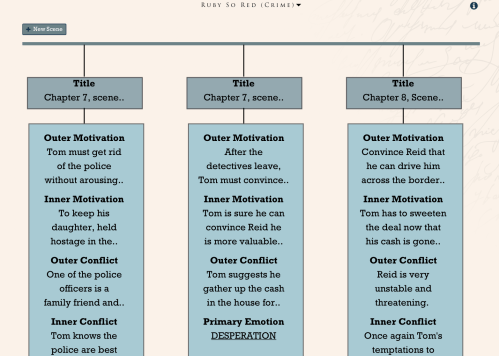
Scene Maps look at planning at the scene level, which can be great both for micro-planning and diagnosing what’s not quite working in your novel. This tool shows you all the major elements a scene should have, and then you can make quick notes about each scene, stringing together as many as you like.
The scene cards are moveable, and come in two versions so you can choose the terminology that fits you best: Formal Scene Maps >> and Informal Scene Maps >>
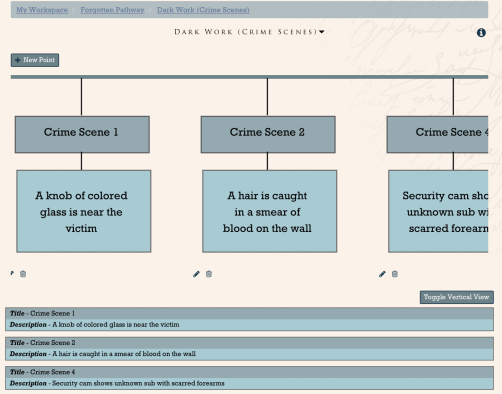
Finally, for Pantsers who prefer less planning, we have the Timeline Tool, which is great for jotting down ideas about possible scenes without structuring them too much.
Like Scene Maps, the cards can be moved around, so play with the order as you storyboard ideas, track events like a series of murders or stops on a character’s quest, and more. Check out the Timeline Tool >>
WorldBuilding SurveysReal-world or not, every story has a foundational “where” and it’s up to you to know this reality inside and out, whether it’s Middle Earth or Chicago.

We created choose-your-own surveys where you drag questions to answer about your story’s where, creating a custom survey. Putting thought into the cities, people, places, government, travel methods, climate, magic, and other key details etc. will help you write settings with authenticity and avoid logic problems that could pull readers out of the story. Find out more >>
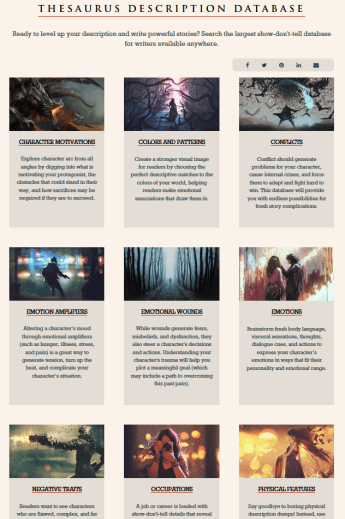 Show-Don’t-Tell Database
Show-Don’t-Tell Database Ideas come to life through description, and the more focus and meaningful the detail, the better readers can imagine what’s happening to the characters they’ve come to care about. But it’s all about choosing the right details, ones that work hard in your story.
Our show-don’t-tell THESAURUS is the largest of its kind, supplying you with non-stop ideas on how to showcase your characters, locations, and story events so readers feel part of each scene and experience. Explore the THESAURUS database >>
Storyteller’s RoadmapWith so many story elements to juggle–plot, pacing, characters, theme, symbolism, arc, dialogue, subtext, story structure and more–getting a novel from that first idea to a publish-ready novel is a huge undertaking. In fact, many writers stop before a story is complete because they got lost along the way, felt stuck, or believed they couldn’t get the story to where it needed to be.

The Storyteller’s Roadmap is the cure for unfinished novels because it guides writers step-by-step through planning, writing, and revising so they always know what to focus on, and have the tools, resources, and knowledge to get past any difficulty or struggle. Visit the Storyteller’s Roadmap >>
Templates, Worksheets, and Generators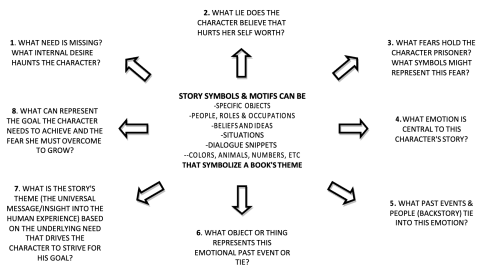
Some writers prefer Templates and Worksheets to help launch their imagination and focus on one thing at a time. We’ve put together some innovative ones that go further than what you might typically see elsewhere.
And if you need an extra brainstorming nudge, the Idea Generator can help you round out a character with a secret or hobby, give you ideas for plot complications, suggest story stakes, and more.
Tip Sheets & Check List DatabaseTaking a story from good to great is done when we optimize everything we can. Our Tip Sheet Database is packed with ways to improve your story and troubleshoot problems. Come download a few – no subscription needed >>
 Is It Time to Try Something New?
Is It Time to Try Something New? All of these tools can be found at One Stop for Writers, so if you’d like to try any of them out, activate the free trial and see if these are a game-changer for you. But if you already have a process that works and feel you have no real struggles on the writing front, keep doing what you’re doing now, because it’s clearly working for you!
The post Game-Changing Creative Tools for New & Advanced Writers appeared first on WRITERS HELPING WRITERS��.
Game-Changing Tools for New & Advanced Writers

One thing that drives all writers is the desire to create a truly amazing story, one a reader can’t put down or forget.
It’s why we’re always learning to deepen our storytelling skills – we want that next book to be our best one yet.
But the learning curve can be frustrating, and it’s hard when so many things are competing for our time. Becca and I know this first hand as we’ve been studying story craft for almost 20 years.
We’ve been sharing what we know for a long time now, both here and at One Stop for Writers. Time is precious, and we want every writing session of yours to be a great one. If you only know us by our thesaurus books, you might be surprised to know we’ve built other tools to help writers think like a story expert so every aspect of their story is as strong as it can be.
Character Builder Tool
This tool at One Stop for Writers contains massive characterization databases for personality traits, emotions, skills, motivations, backstory wounds, physical features, occupations, and more, so planning original characters is incredibly easy. Even better, this tool uses psychology to show you how each element or quality you choose will alter how your character thinks and behaves, meaning it will be much easier to write their actions and responses in ways that line up with who they are.
Did we mention the Character Builder also identifies key details as you brainstorm and builds a character arc blueprint for you? See this tool in action >>
Story Map, Scene Maps, and Timeline Tools
Every writer has their own process when it comes to planning a story or novel. Some prefer to fully outline a story tip to toe so they know exactly which events they are writing towards, and see how plot and character arc work together. Story Maps is great for this, especially as it helps you navigate story structure so you end up with a strong story foundation. Visit Story Maps >>

Scene Maps look at planning at the scene level, which can be great both for micro-planning and diagnosing what’s not quite working in your novel. This tool shows you all the major elements a scene should have, and then you can make quick notes about each scene, stringing together as many as you like.
The scene cards are moveable, and come in two versions so you can choose the terminology that fits you best: Formal Scene Maps >> and Informal Scene Maps >>

Finally, for Pantsers who prefer less planning, we have the Timeline Tool, which is great for jotting down ideas about possible scenes without structuring them too much.
Like Scene Maps, the cards can be moved around, so play with the order as you storyboard ideas, track events like a series of murders or stops on a character’s quest, and more. Check out the Timeline Tool >>
WorldBuilding SurveysReal-world or not, every story has a foundational “where” and it’s up to you to know this reality inside and out, whether it’s Middle Earth or Chicago.

We created choose-your-own surveys where you drag questions to answer about your story’s where, creating a custom survey. Putting thought into the cities, people, places, government, travel methods, climate, magic, and other key details etc. will help you write settings with authenticity and avoid logic problems that could pull readers out of the story. Find out more >>
 Show-Don’t-Tell Database
Show-Don’t-Tell Database Ideas come to life through description, and the more focus and meaningful the detail, the better readers can imagine what’s happening to the characters they’ve come to care about. But it’s all about choosing the right details, ones that work hard in your story.
Our show-don’t-tell THESAURUS is the largest of its kind, supplying you with non-stop ideas on how to showcase your characters, locations, and story events so readers feel part of each scene and experience. Explore the THESAURUS database >>
Storyteller’s RoadmapWith so many story elements to juggle–plot, pacing, characters, theme, symbolism, arc, dialogue, subtext, story structure and more–getting a novel from that first idea to a publish-ready novel is a huge undertaking. In fact, many writers stop before a story is complete because they got lost along the way, felt stuck, or believed they couldn’t get the story to where it needed to be.

The Storyteller’s Roadmap is the cure for unfinished novels because it guides writers step-by-step through planning, writing, and revising so they always know what to focus on, and have the tools, resources, and knowledge to get past any difficulty or struggle. Visit the Storyteller’s Roadmap >>
Templates, Worksheets, and Generators
Some writers prefer Templates and Worksheets to help launch their imagination and focus on one thing at a time. We’ve put together some innovative ones that go further than what you might typically see elsewhere.
And if you need an extra brainstorming nudge, the Idea Generator can help you round out a character with a secret or hobby, give you ideas for plot complications, suggest story stakes, and more.
Tip Sheets & Check List DatabaseTaking a story from good to great is done when we optimize everything we can. Our Tip Sheet Database is packed with ways to improve your story and troubleshoot problems. Come download a few – no subscription needed >>
 Is It Time to Try Something New?
Is It Time to Try Something New? All of these tools can be found at One Stop for Writers, so if you’d like to try any of them out, activate the free trial and see if these are a game-changer for you. But if you already have a process that works and feel you have no real struggles on the writing front, keep doing what you’re doing now, because it’s clearly working for you!
Black Friday Offer: Save 40% at One Stop for Writers
We love to see writers get the help they need, so if you’d like to come join the family, use this one-use discount code:
BF2022
And save 40% when you subscribe to the 6-month plan.
We hope you can put these savings to good use. Just activate this code by November 30th, 2022, and we’ll see you at One Stop!
The post Game-Changing Tools for New & Advanced Writers appeared first on WRITERS HELPING WRITERS��.
November 21, 2022
Phenomenal First Pages Contest
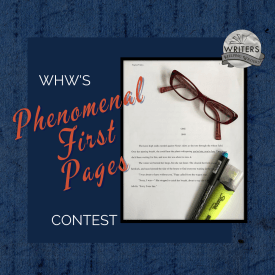 Hey, wonderful writerly people! It���s time for our monthly first-page critique contest
Hey, wonderful writerly people! It���s time for our monthly first-page critique contest 
If you���re working on a first page (in any genre except erotica) and would like some objective feedback, please leave a comment. Any comment :). As long as the email address associated with your WordPress account/comment profile is up-to-date, I���ll be able to contact you if your first page is chosen. Just please know that if I���m unable to get in touch with you through that address, you���ll have to forfeit your win.
Two caveats:
 Please be sure your first page (double-spaced in 12-point font) is ready to go so I can critique it before next month���s contest rolls around. If it needs some work and you won���t be able to get it to me right away, let me ask that you plan on entering the next contest, once any necessary tweaking has been taken care of.
Please be sure your first page (double-spaced in 12-point font) is ready to go so I can critique it before next month���s contest rolls around. If it needs some work and you won���t be able to get it to me right away, let me ask that you plan on entering the next contest, once any necessary tweaking has been taken care of.
 This contest only runs for 24 hours, start to finish, so get your comment in there!
This contest only runs for 24 hours, start to finish, so get your comment in there!
Three commenters��� names will be randomly drawn and posted tomorrow morning. If you win, you can email me your first page and I���ll offer my feedback.
We run this contest on a monthly basis, so if you���d like to be notified when the next opportunity comes around, consider subscribing to our blog (see the right-hand sidebar).
Best of luck!
PS: If you want to amp up your first page, grab our helpful First Pages checklist from One Stop for Writers. And for more instruction on these important opening elements, see this Mother Lode of First Page Resources.The post Phenomenal First Pages Contest appeared first on WRITERS HELPING WRITERS��.
Writers Helping Writers
- Angela Ackerman's profile
- 1014 followers



